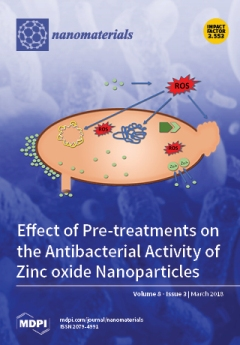In recent years, many research groups have synthesized ultra-thin silver nanowires (AgNWs) with diameters below 30 nm by employing Cl
− and Br
− simultaneously in the polyol process. However, the yield of AgNWs in this method was low, due to the production
[...] Read more.
In recent years, many research groups have synthesized ultra-thin silver nanowires (AgNWs) with diameters below 30 nm by employing Cl
− and Br
− simultaneously in the polyol process. However, the yield of AgNWs in this method was low, due to the production of Ag nanoparticles (AgNPs) as an unwanted byproduct, especially in the case of high Br
− concentration. Here, we investigated the roles of Cl
− and Br
− in the preparation of AgNWs and then synthesized high aspect ratio (up to 2100) AgNWs in high yield (>85% AgNWs) using a Cl
− and Br
− co-mediated method. We found that multiply-twinned particles (MTPs) with different critical sizes were formed and grew into AgNWs, accompanied by a small and large amount of AgNPs for the NaCl and NaBr additives, respectively. For the first time, we propose that the growth of AgNWs of different diameters and yields can be understood based on the electron trap distribution (ETD) of the silver halide crystals. For the case of Cl
− and Br
− co-additives, a mixed silver halide crystal of AgBr
1−xCl
x was formed, rather than the AgBr/AgCl mixture reported previously. In this type of crystal, the ETD is uniform, which is beneficial for the synthesis of AgNWs with small diameter (30~40 nm) and high aspect ratio. AgNW transparent electrodes were prepared in air by rod coating. A sheet resistance of 48 Ω/sq and transmittance of 95% at 550 nm were obtained without any post-treatment.
Full article






